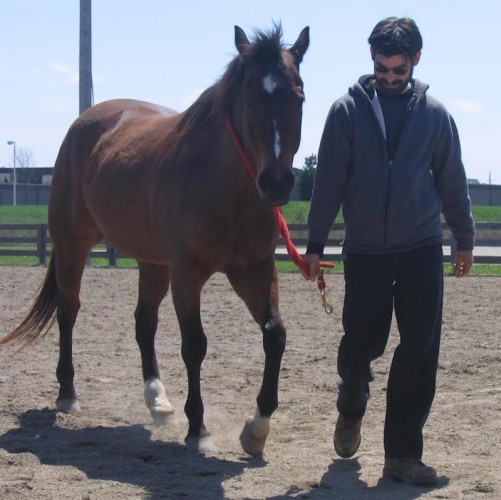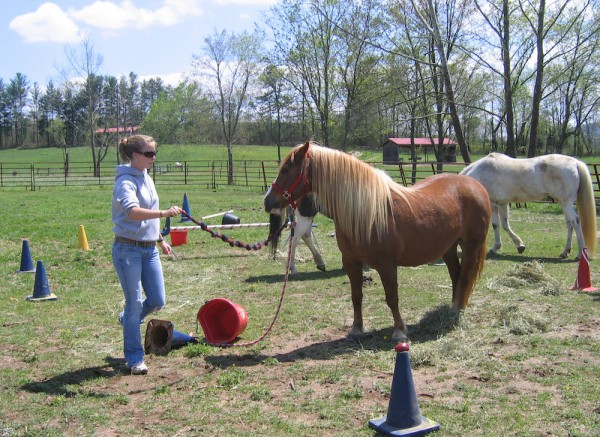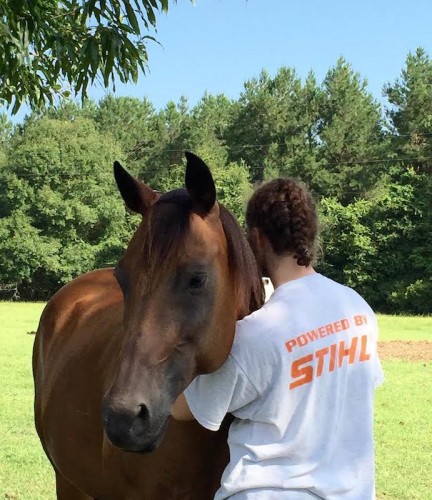Horses are amazing. This is a fact that has become abundantly clear to me throughout the 2+ years I’ve worked with horses as a Equine Assisted Growth and Learning Association (EAGALA) licensed therapist. When I attended my first EAGALA training session I learned that one of the core tenets of the organization’s model is “the horses’ job is to be themselves.” Meaning, the horses do not need to be micro-managed, nor do they need any kind of specific training to do this kind of work. Instead, we are simply using their instincts and natural patterns of relating as a useful component for therapy.

(courtesy of EAGALA)
Horses live in an action and behavior based world. Their entire perception of you is based on what you do. Words cannot manage their impressions. They do not care what you say or what you look like. They have no understanding of human stereotypes. You can’t make them think better of you or less of someone else by what you tell them. Their interactions with you happen only through your attitudes and actions. Showing consistency between your outside demeanor and your inside will is all the horse cares about. This is what makes the horse such an effective therapy tool.

(courtesy of EAGALA)
Coming into this role, I thought I knew what EAGALA trainers had in mind about letting the horses “be themselves.” When it comes to working with and training horses, I’m no rookie. I’ve had the opportunity to work under some of the best in the equine business. I know all about respecting the horse as an individual and making sure that they are enjoying their work—all the things you care about when your horse is a friend and a passion and not just a tool for fun and sport. I thought I knew it all, but little did I know…
Lending an ear
A therapist called me about an upcoming session with a child named “Luke”. Luke is a “drug baby” with developmental delays who was struggling to cope well in his residential unit. As a hyperactive child prone to angry outbursts, the staff was debating whether to bring him at all. I told the therapist that we would give it a shot and the facility brought a few extra staff to “help” with Luke.
The next day, a small, discombobulated and very hyperactive little boy entered our session. Luke walked right up to the biggest horse in the ring and attempted to poke him in the eye. The horse, Han, is a towering 17.2-hand, big-bodied, jet-black warmblood who was once a competitive show horse and one of the most charming souls you’ll ever meet. He was completely un-phased by Luke’s antics, and lowered his head to investigate the small boy further.
During Luke’s group session each boy in the group was asked to write down a goal on a poster at the end of the arena. The children would then work to get the horse from one end of the ring to their “goal”, getting past several “obstacles” along the way. Luke wanted to work with Han who dutifully walked beside him all the way to the end of the ring. Luke looked up at Han, and pointing to his poster said, “This is my goal. It says I want to go home and listen better—I’m not very good at listening.” As Luke was talking, Han reached out his long neck and touched the goal with his nose. Then he gently rested his head on the boy’s shoulder. A picture perfect moment.
The facility therapist leaned over and whispered, “Did you train him to do that?”
It’s a question I’m asked many times and the answer is always the same: “No.”

(courtesy of EAGALA)
Bully Buster
One day during a group session I noticed my ever so cooperative former lesson pony being anything but cooperative. His feet were planted and he refused to move for anyone in the arena except a particular teenaged boy with a severe stutter. He followed this boy around like a puppy but would not budge for anyone else. I later found out this boy had been teased and shunned by the other boys in the group. Well, that day, the group had to rely on the “boy with the stutter” to accomplish any of their tasks with the horses.
Pick-me up
My very respectful and very large warmblood kept nudging one of the children in the shoulder. Over and over, nudge, nudge, nudge. It was clearly deliberate and became more and more pushy. I was taken aback because this particular horse never invades anyone’s body space. He was very well trained and even in his most relaxed moments would not invade the “bubble.”
“It looks like the horse keeps putting his nose on you and moving his head,” I said to the boy. “What’s up with that?”
“Han knows I’m having a bad day,” he responded. “I don’t get to go home for Christmas.”
The little boy had come to the session with his typical smile, so the staff and I had no idea he was having a bad day. This horse had not exhibited that behavior before this session and I have not seen it since.

(courtesy of EAGALA)
Tough love
During a recent session my mare, Milah, was repeatedly pinning her ears at a particular child. Milah is our “farm diva” but likes everyone, so seeing her pin her ears was very out of character. However, each session her posture towards this boy seemed to be getting worse. When another child would approach, her ears would return forward and her head would lower, showing a change in her attitude. It happened several times before I knew for sure that this particular boy was causing the attitude shift in my mare. As it turned out, he had been making inappropriate comments about the female staff, including me.
My mare didn’t know he was speaking about us of course, but she recognized the malicious attitude the boy displayed.

(courtesy of EAGALA)
I can throw out a number of reasons for these seemingly magical moments. I can tell you how horses are naturally disarming and possess an amazing ability to reduce stress. I can tell you that horses are flight animals and rely heavily on their hypervigilance to keep them alive. I could also talk about biofeedback or, as some have called it, the limbic path.
All I know for certain is that when interacting with horses, I watch people become the best version of themselves. I watch them connect with hope, insight and courage. No masks, no posturing, no impression management. Simply the power to change the atmosphere inside the ring, and watching that translate to the atmosphere outside the ring.

(courtesy of EAGALA)
Maybe that’s why equine therapy is becoming recognized around the globe as a groundbreaking form of therapy. Maybe that’s why many programs are able to report a success rate higher than that of traditional therapies (even as high as 95%).
Winston Churchill was right: “There is something about the outside of a horse that is good for the inside of a person.” Horses really are amazing.
About the Author
Kari Whatley is a licensed Professional Counselor certified by the Equine Assisted Growth and Learning Association (EAGALA). Kari manages the Equine Therapy Group, LLC and the Equine Therapy Group Foundation, serving children and at risk youth, families and veterans. A lifelong equestrian, she enjoys Eventing and Polocrosse.


 August 25, 2015
August 25, 2015 
























